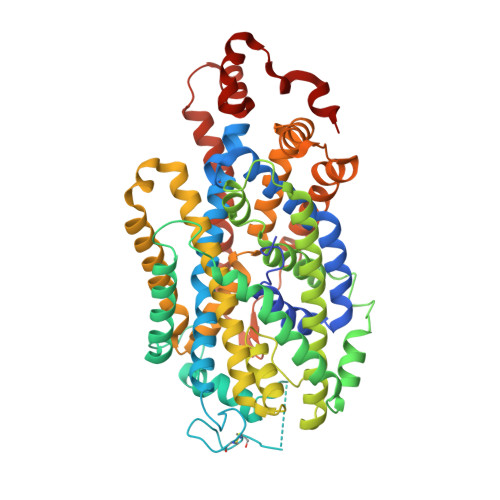Transport and inhibition mechanisms of the human noradrenaline transporter.
Hu, T., Yu, Z., Zhao, J., Meng, Y., Salomon, K., Bai, Q., Wei, Y., Zhang, J., Xu, S., Dai, Q., Yu, R., Yang, B., Loland, C.J., Zhao, Y.(2024) Nature 632: 930-937
- PubMed: 39085602
- DOI: https://doi.org/10.1038/s41586-024-07638-z
- Primary Citation of Related Structures:
8WTU, 8WTV, 8WTW, 8WTX, 8WTY - PubMed Abstract:
The noradrenaline transporter (also known as norepinephrine transporter) (NET) has a critical role in terminating noradrenergic transmission by utilizing sodium and chloride gradients to drive the reuptake of noradrenaline (also known as norepinephrine) into presynaptic neurons 1-3 . It is a pharmacological target for various antidepressants and analgesic drugs 4,5 . Despite decades of research, its structure and the molecular mechanisms underpinning noradrenaline transport, coupling to ion gradients and non-competitive inhibition remain unknown. Here we present high-resolution complex structures of NET in two fundamental conformations: in the apo state, and bound to the substrate noradrenaline, an analogue of the χ-conotoxin MrlA (χ-MrlA EM ), bupropion or ziprasidone. The noradrenaline-bound structure clearly demonstrates the binding modes of noradrenaline. The coordination of Na + and Cl - undergoes notable alterations during conformational changes. Analysis of the structure of NET bound to χ-MrlA EM provides insight into how conotoxin binds allosterically and inhibits NET. Additionally, bupropion and ziprasidone stabilize NET in its inward-facing state, but they have distinct binding pockets. These structures define the mechanisms governing neurotransmitter transport and non-competitive inhibition in NET, providing a blueprint for future drug design.
Organizational Affiliation:
National Laboratory of Biomacromolecules, CAS Center for Excellence in Biomacromolecules, Institute of Biophysics, Chinese Academy of Sciences, Beijing, China.


















